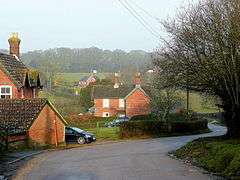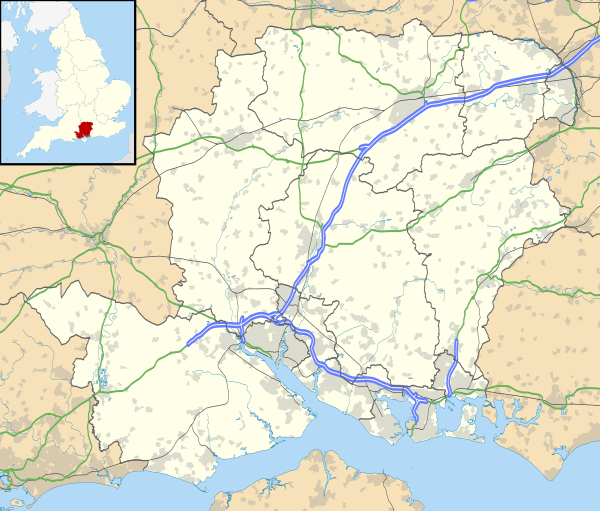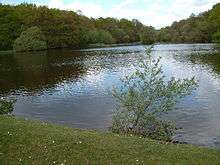Fritham
Fritham is a small village in Hampshire, England. It lies in the north of the New Forest, near the Wiltshire border. It is in the civil parish of Bramshaw.[1]
| Fritham | |
|---|---|
 Fritham | |
 Fritham Location within Hampshire | |
| OS grid reference | SU239141 |
| District |
|
| Shire county | |
| Region | |
| Country | England |
| Sovereign state | United Kingdom |
| Post town | LYNDHURST |
| Postcode district | SO43 |
| Dialling code | 023 |
| Police | Hampshire |
| Fire | Hampshire |
| Ambulance | South Central |
| UK Parliament | |
History
The name Fritham may be derived from Old English meaning a cultivated plot (hamm) in scrub on the edge of a forest (fyrhth).[2]
The oldest feature in Fritham is a Bronze Age Bowl barrow, known as The Butt, which lies just east of the village, although it has been partially damaged on top by a brick structure.[3]
Fritham is not mentioned in the Domesday Book of 1086.[4] It was once thought that the Domesday settlement of Truham (or Trucham) may have been Fritham,[5] but this is now thought unlikely as Truham was within Boldre Hundred.[4] The first mention of Fritham appears early in the 13th century,[2] when Geoffrey de Baddesley held land in Baddesley and Fritham. Fritham remained attached to the manor of South Baddesley in the parish of Boldre at least until 1429.[5]
The Royal Oak - a thatched cottage with red-brick additions - is one of the oldest pubs in the New Forest, dating back to the 17th century.[6] Fritham Lodge, dating from 1671, may have been one of Charles II hunting lodges.[7] A school and chapel opened in Fritham in 1861.[5]
From the 1860s until the 1920s Fritham was home to the Schultze gunpowder factory.[8] The factory specialised in smokeless powder for sporting guns.[8] Established in 1865, it was at one time the largest nitro-compound gunpowder factory in the world, with sixty separate buildings and a staff of one hundred.[9] It supplied three-quarters of the world's annual consumption of gunpowder for sporting purposes and often sent 100-ton consignments to the Americas loading road vans and special railway trucks for the docks at Southampton.[9] Little now remains of the factory except for the superintendent's and gatekeeper's houses.[10] Eyeworth Pond, near Fritham, was specially created by the factory as a reservoir to hold water needed during the manufacturing process.[10]
Four young men from Fritham went down with the Titanic in 1912: Lewis Hickman (aged 32), Leonard Mark Hickman (aged 24), Stanley George Hickman (aged 21), and Ambrose Hood (aged 21).[11] A gravestone in memory of the Hickman brothers can be found in Riverside Cemetery in the town of Neepawa in Manitoba, Canada.[12]
The Ham class minesweeper HMS Fritham, launched in 1953, was named after the village.
Notes
- Bramshaw Parish Council Archived 2011-10-03 at the Wayback Machine
- Old Hampshire Gazetteer - Fritham
- Hampshire Treasures - Bramshaw, page 21 Archived 2011-06-05 at the Wayback Machine
- Througham (Truham) Archived 2015-09-30 at the Wayback Machine, Pastscape
- Victoria County History, (1912), A History of the County of Hampshire: Volume 5, Pages 623-626
- Hampshire pub guide: The Royal Oak, Fritham, The Telegraph, 03 Mar 2011
- Fritham Lodge, Bramshaw British Listed Buildings
- Norman Henderson, (2007), A Walk Around the New Forest: In Thirty-Five Circular Walks, pages 87-8. Frances Lincoln
- Kenneth Hudson, (1968), The industrial archaeology of southern England: Hampshire, Wiltshire, Dorset, Somerset, and Gloucestershire east of the Severn, page 35
- Eyeworth Pond, Fritham, and the Schultze Gunpowder Factory
- The Royal Oak, Fritham Archived 26 April 2015 at the Wayback Machine, Lymington.org
- Find A Grave website
External links
| Wikimedia Commons has media related to Fritham. |
- Eyeworth Pond, Fritham, and the Schultze Gunpowder Factory, New Forest Explorers Guide

